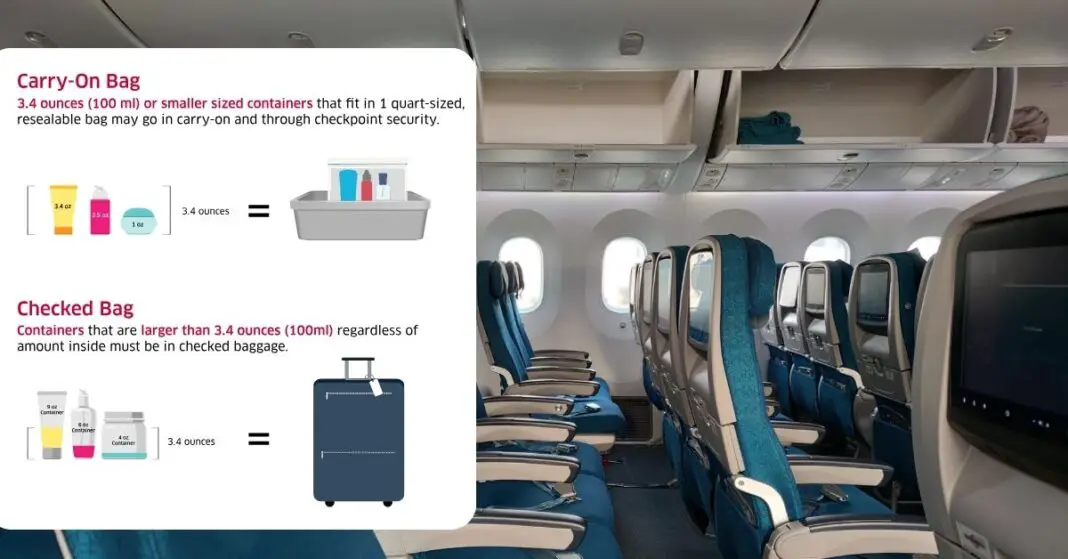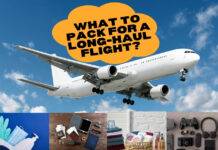In today’s travel landscape, navigating the complexities of what you can and cannot bring aboard a plane can often be an overwhelming task. One of the key regulations to understand, particularly when it involves carry-on items, is the Transportation Security Administration’s (TSA) 3-1-1 Rule.
Designed to streamline security checks and enhance safety, this rule refers to the number of liquids, gels, and aerosols travelers can bring onto a plane.
However, this is not a blanket rule, as there are various exceptions and exemptions for specific needs such as medications or child nourishment. More so, international flights might enforce their own set of rules, possibly even stricter than TSA regulations. Hence, being well-informed about these rules can contribute to a hassle-free traveling experience.
Table of Contents
TSA Liquids Rule
The romance of constantly traversing the globe is intricately woven with packing decisions. And, one of the stars of this voyage is the ubiquitous carry-on bag. Today, let’s dive into the nitty-gritty of one such regulation that often finds travelers flummoxed at security checkpoints – the TSA 3-1-1 rule.
Dreams of zipping through airport security checkpoints aren’t far-fetched, they just need a bit of knowledge, a pinch of preparation, and voila, you’re ready! So, what is this TSA 3-1-1 rule? From a digital nomad who loves to glide through anywhere life chooses to transport to, here’s the lowdown.
The TSA 3-1-1 rule, implemented by the Transportation Security Administration (TSA), mandates that all liquids, gels, aerosols, creams, and pastes in your carry-on must not exceed 3.4 ounces or 100 milliliters per item. These pint-sized items should then all fit into a single, quart-sized clear and sealable plastic bag.
Quite essentially, it stands as: 3.4 ounces-1 quart-sized bag- 1 Bag per passenger-. That’s where the aptly named 3-1-1 rule comes from. Voila, it’s that simple!
But hang on a minute, why such an oddball regulation, you may wonder? It’s all thanks to a certain potential safety threat that small containers of unusual substances can pose on airlines. The TSA 3-1-1 rule is the TSA’s agile response to ensuring security while facilitating smooth travel for wanderers like us!
Now, there are exceptions to this rule, cause life’s a grand adventure! Medically necessary items, infant and child nourishment like formula, breast milk, and juice are usually exempt. Yes, kids’ snacks are typically okay too. Just ensure to inform the TSA Officer these are present at the beginning of the screening process, and they’re usually cool to go.
Pro tip from one nomad to another: Keep your 3-1-1 baggie easily accessible, as you will need to place it into a bin separately when passing through security. It hastens the process, and let’s be honest, who doesn’t enjoy having an extra mocha latte instead of getting tangled up in security norms?
In the grand nature of wanderlust, it’s important to remember that variations to this rule may occur based on countries outside the U.S. and different airlines. It’s the wisest choice to always double-check specifics before each adventure.
Exceptions and Exemptions
Strolling deeper into the labyrinth of the TSA’s 3-1-1 rule, we float now to various exceptions. Riddled with misconceptions, and nestled with nuances, this rule hides within its exemptions aplenty. So don’t let the pressure of the fluid rule throw a curveball at your plans, as we’ve got you covered with snippets of exemptions that can potentially serve you a faster pass through the security checks.
Venture into the world of cosmetics! Solid cosmetics and personal hygiene items are a free pass, as the 3-1-1 rule concerns itself solely with liquids, gels, aerosols, and creams. Wax on your surfboard, layer on your stick deodorants and lip balms, or apply your dry shampoo or mascara, all without the watchful eye of the TSA.
Next, crawling into the realm of food. Liquid or gel food items for the journey, from peanut butter and cheese spreads to Greek yogurt and all other smoothies, fit snugly under the 3-1-1 banner. But travelers, repack your fear as your pies and cakes are clear for inspection, and will most likely pass undeterred through the security checks.
Duty-free liquids are also, quite interestingly, an exception to the rule. Purchased internationally, these items are permitted within your carry-on luggage provided they are sealed in the verifiable secure, tamper-evident bag by the retailer. But bear in mind, this might call for some additional screening at security.
Now, shifting onto the path less trodden, let’s acknowledge the support for musical instruments. Orchestra members, acapella aficionados, and buskers rejoice! Special items like musical instruments can be transported separately from your carry-on baggage, following negotiation with airlines.
And then, we leap to the life-saving devices. Portable oxygen concentrators, CPAP machines, Nebulizers, and other necessary medical devices are welcomed aboard sans the volume restrictions of the TSA guideline. Do keep these devices unscathed from the 3-1-1 rule by informing officers of their presence before the beginning of the screening process.
So, as we wave off onto the horizons of our next adventure, let these tricks echo in your mind. Rules are there, but exceptions also abide the land of travel. Embrace the freedom, and the novelty of exploration with few lesser worries, all while staying compliant with guidelines. So ready, set, pack those bags – the world is waiting for you!
International Travel
Now that we’ve got the basics down on the TSA 3-1-1 rule, let’s dive into an important facet of globe-trotting that often stumps even the most accomplished travelers: international restrictions for carry-on liquids. After all, the nitty-gritty of travel can often prove a little perplexing, right?
Just as every country has its unique charm, it also has its distinct set of rules. While the TSA 3-1-1 rule is generally accepted globally, it’s crucial to know how it’s tweaked and fine-tuned across different borders. Life’s an adventure, they say, and so is packing your carry-on liquids for international flights!
Let’s start our journey with our friends to the North, Canada. Transport Canada’s liquid rules echo the TSA regulations, but they emphasize one crucial addition: powders. Yes, dear explorers, if you’re heading to or transiting through Canada, powders and granulated materials in containers of 350 ml or more are a no-go.
Hop over to the European Union, and you’ll find they march to a slightly different tune. Travelers can carry liquids in containers up to 100 ml, but they all must fit into a clear, resealable plastic bag with a total capacity not exceeding one liter.
When venturing to the land of beautiful beaches and colorful culture, Australia, remember to pack medicines and baby products separately. These items do not count towards the general liquid, aerosol, and gel limit.
On the Eastern side of the world, China is pretty aligned with TSA rules but note that some domestic flights may have stricter controls. If transiting through China, any duty-free liquid items purchased elsewhere must be sealed and unopened.
One might wonder, “What about the land of colorful spices and diverse cultures, India?” The Bureau of Civil Aviation Security allows liquids in hand luggage following the TSA 3-1-1 rule but states all aerosol items, gels, creams, and pastes must be packed together and separated from other luggage during the security screening.
Frequent fliers often wonder whether making a pitstop at the duty-free shop after security will flout the carry-on liquid rules. Good news, thoughtful explorers!
Duty-free liquids over 100 ml are allowed in your carry-on as long as they are purchased at the airport and are packed in a tamper-evident bag with the receipt visible. Remember, though, that the rules may vary based on your transit and destination countries, so best to double-check before splurging on that giant bottle of perfume.
At the end of the day, the golden rule when it comes to tackling carry-on liquid restrictions is to do your homework before every journey. While it might seem tedious, following these rules can pave the way for serene skies and smooth landings. So get packing, globetrotters! Adventure awaits, and now, it’s just a 3-1-1 rule away.
Ultimately, understanding the TSA’s 3-1-1 rule, its exceptions, and the distinctions for international travel is a fundamental part of contemporary travel.
While it may seem daunting, being knowledgeable about these regulations can help mitigate potential stress points during your journey. Remember, the standard carry-on allowance is generally 3.4 ounces per item, packed into a single, clear, and zip-top bag.
However, certain necessities like infant food or critical medications may qualify as exceptions. Keep in mind, also, that globally, rules can vary, and airspace authorities in other countries can impose tighter restrictions. Safe and informed traveling lends itself to more enjoyable and memorable journeys.
Can you take 4 oz on a plane?
No, according to TSA regulations, you cannot take 4 oz on a plane. The 3-1-1 rule dictates that liquids, gels, and aerosols must be in containers holding up to 3.4 ounces. This means your liquids must adhere to the 3-ounce limit, fit into a 1-quart bag (the first “1”), and you’re allowed only one such bag (the final “1”). Stick to these guidelines for a smooth security screening process.
Can I bring a 4 oz toothpaste on a plane?
A 4 oz toothpaste cannot be carried in your carry-on luggage when flying. The Transportation Security Administration (TSA) enforces a liquids rule, restricting the amount of liquids, gels, and aerosols allowed in your carry-on to 3.4 ounces (100 milliliters) per container.
How many 3 oz bottles can I carry-on?
You can usually fit approximately 7 or 8 3 oz bottles in your carry-on luggage, though the exact number might vary slightly based on packing technique and the type of bottles used.
Does deodorant count as a liquid?
In most cases, deodorant is not considered a liquid by the Transportation Security Administration (TSA). Solid or gel deodorants are generally allowed in both carry-on and checked luggage.
However, it’s important to note that aerosol deodorants, which are in spray form, are treated as liquids and must adhere to the TSA’s liquids rule, meaning they should be in containers of 3.4 ounces (100 milliliters) or less and fit into a quart-sized, resealable plastic bag. Always check the specific guidelines of the airline and TSA for the most accurate and up-to-date information.





